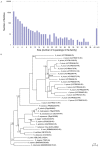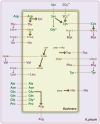Genome sequence of the pea aphid Acyrthosiphon pisum
- PMID: 20186266
- PMCID: PMC2826372
- DOI: 10.1371/journal.pbio.1000313
Genome sequence of the pea aphid Acyrthosiphon pisum
Erratum in
-
Correction: Genome Sequence of the Pea Aphid Acyrthosiphon pisum.PLoS Biol. 2018 Sep 13;16(9):e3000029. doi: 10.1371/journal.pbio.3000029. eCollection 2018 Sep. PLoS Biol. 2018. PMID: 30212454 Free PMC article.
Abstract
Aphids are important agricultural pests and also biological models for studies of insect-plant interactions, symbiosis, virus vectoring, and the developmental causes of extreme phenotypic plasticity. Here we present the 464 Mb draft genome assembly of the pea aphid Acyrthosiphon pisum. This first published whole genome sequence of a basal hemimetabolous insect provides an outgroup to the multiple published genomes of holometabolous insects. Pea aphids are host-plant specialists, they can reproduce both sexually and asexually, and they have coevolved with an obligate bacterial symbiont. Here we highlight findings from whole genome analysis that may be related to these unusual biological features. These findings include discovery of extensive gene duplication in more than 2000 gene families as well as loss of evolutionarily conserved genes. Gene family expansions relative to other published genomes include genes involved in chromatin modification, miRNA synthesis, and sugar transport. Gene losses include genes central to the IMD immune pathway, selenoprotein utilization, purine salvage, and the entire urea cycle. The pea aphid genome reveals that only a limited number of genes have been acquired from bacteria; thus the reduced gene count of Buchnera does not reflect gene transfer to the host genome. The inventory of metabolic genes in the pea aphid genome suggests that there is extensive metabolite exchange between the aphid and Buchnera, including sharing of amino acid biosynthesis between the aphid and Buchnera. The pea aphid genome provides a foundation for post-genomic studies of fundamental biological questions and applied agricultural problems.
Conflict of interest statement
The authors have declared that no competing interests exist.
Figures












Similar articles
-
A dual-genome microarray for the pea aphid, Acyrthosiphon pisum, and its obligate bacterial symbiont, Buchnera aphidicola.BMC Genomics. 2006 Mar 14;7:50. doi: 10.1186/1471-2164-7-50. BMC Genomics. 2006. PMID: 16536873 Free PMC article.
-
Genomic evidence for complementary purine metabolism in the pea aphid, Acyrthosiphon pisum, and its symbiotic bacterium Buchnera aphidicola.Insect Mol Biol. 2010 Mar;19 Suppl 2:241-8. doi: 10.1111/j.1365-2583.2009.00945.x. Insect Mol Biol. 2010. PMID: 20482654
-
Genomic insight into the amino acid relations of the pea aphid, Acyrthosiphon pisum, with its symbiotic bacterium Buchnera aphidicola.Insect Mol Biol. 2010 Mar;19 Suppl 2:249-58. doi: 10.1111/j.1365-2583.2009.00942.x. Insect Mol Biol. 2010. PMID: 20482655
-
Genomic revelations of a mutualism: the pea aphid and its obligate bacterial symbiont.Cell Mol Life Sci. 2011 Apr;68(8):1297-309. doi: 10.1007/s00018-011-0645-2. Epub 2011 Mar 10. Cell Mol Life Sci. 2011. PMID: 21390549 Free PMC article. Review.
-
Systemic analysis of the symbiotic function of Buchnera aphidicola, the primary endosymbiont of the pea aphid Acyrthosiphon pisum.C R Biol. 2009 Nov;332(11):1034-49. doi: 10.1016/j.crvi.2009.09.007. Epub 2009 Oct 14. C R Biol. 2009. PMID: 19909925 Review.
Cited by
-
Host generated siRNAs attenuate expression of serine protease gene in Myzus persicae.PLoS One. 2012;7(10):e46343. doi: 10.1371/journal.pone.0046343. Epub 2012 Oct 10. PLoS One. 2012. PMID: 23071558 Free PMC article.
-
Phylloxera and Aphids Show Distinct Features of Genome Evolution Despite Similar Reproductive Modes.Mol Biol Evol. 2023 Dec 1;40(12):msad271. doi: 10.1093/molbev/msad271. Mol Biol Evol. 2023. PMID: 38069672 Free PMC article.
-
Experimental replacement of an obligate insect symbiont.Proc Natl Acad Sci U S A. 2015 Feb 17;112(7):2093-6. doi: 10.1073/pnas.1420037112. Epub 2015 Jan 5. Proc Natl Acad Sci U S A. 2015. PMID: 25561531 Free PMC article.
-
On the transposon origins of mammalian SCAND3 and KRBA2, two zinc-finger genes carrying an integrase/transposase domain.Mob Genet Elements. 2012 Sep 1;2(5):205-210. doi: 10.4161/mge.22914. Mob Genet Elements. 2012. PMID: 23550032 Free PMC article.
-
Pathogen-origin horizontally transferred genes contribute to the evolution of Lepidopteran insects.BMC Evol Biol. 2011 Dec 12;11:356. doi: 10.1186/1471-2148-11-356. BMC Evol Biol. 2011. PMID: 22151541 Free PMC article.
References
-
- Blackman R. L, Eastop V. F. 2000. Aphids on the world's crops: an identification and information guide. Wiley, John & Sons, Incorporated. 476 p.
-
- Morrison W. P, Peairs F. B. Response model concept and economic impact. In: Quisenberry S. S, Peairs F. B, editors. Response model for an introduced pest—the Russian wheat aphid. Lanham, MD: Entomological Society of America; 1998.
-
- Oerke E-C. Estimated crop losses in wheat. In: Oerke E-C, Dehne H-W, Schonbeck F, Weber A, editors. Crop production and crop protection: estimated losses in major food and cash crops. Amsterdam: Elsevier; 1994. pp. 179–296.
-
- Moran N. A, Munson M. A, Baumann P, Ishikawa H. A molecular clock in endosymbiotic bacteria is calibrated using the insect hosts. Proc: Biol Sci. 1993;253:167–171.
Publication types
MeSH terms
Grants and funding
LinkOut - more resources
Full Text Sources
Other Literature Sources
Miscellaneous

